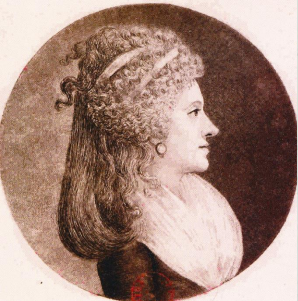Top Qs
Timeline
Chat
Perspective
Marie-Jeanne de Lalande
French astronomer and mathematician (1768-1832) From Wikipedia, the free encyclopedia
Remove ads
Marie-Jeanne Amélie Lefrançois de Lalande (née Harlay;[1] 1768[2] – 8 November 1832) was a French astronomer. She was a key collaborator to the works of Jérôme Lalande.
Her reputation as a scientific woman was attested by an anecdote related to Carl Friedrich Gauss: In 1806, during a military campaign in Prussia, he declared he knew but one French woman that worked in Science, Madame Lefrançois de Lalande."[3]
Remove ads
Biography
Summarize
Perspective
Marie-Jeanne Harlay was born in Paris in 1768, daughter of school teachers Jean François Harlay (born 1730) and Anne Elisabeth Cany (born 1744).[4] Some early authors considered her the illegitimate daughter of Jérôme Lalande.[4]
Jérome Lalande taught Marie-Jeanne Harlay astronomy.[4] Jérôme Lalande was said to have valued Harlay for her mathematical disposition.[5] Michel Lefrançois de Lalande, nephew of Jérôme Lalande, also learned astronomy with his oncle and married Marie-Jeanne in 1788.[1][4] Jérome Lalande referred to Michel Lefrançois and Marie-Jeanne de Lalande as his nephew and her niece.[4]
Michel Lefrançois succeeded Lalande at the École militaire and carried a large star survey with the help of his wife, but she was not listed among the authors.[4]
Marie-Jeanne and Michel Lefrançois de Lalande had four children. Their son Isaac Lefrançais de Lalande was named after Isaac Newton.[6][4] Their second child, Caroline was named after Caroline Herschel, her birth date, 20 January 1790 being the first day a Comet discovered by Herschel was visible from Paris.[1] Caroline died as an infant.[4] Their third child Charlotte Uranie Lefrançais de Lalande was the goddaughter the astronomer Jean Baptiste Joseph Delambre and Charlotte of Saxe-Meiningen.[4] Their fourth child was named Charles Auguste Frédéric Jérôme Lefrançais de Lalande.[4]
De Lalande lectured in astronomy in Paris.[4] During the French Revolution, the chief of the Paris Observatory, Dominique, comte de Cassini, asked Marie-Jeanne for help. She taught Cassini's son and helped him make his first observations of at the Collège de France.[4]
De Lalande and the Duchess Charlotte of Saxe-Meiningen were the only female astronomers that participated at the First European congress of astronomers in 1798.[7] During the trip, the Duchess added the name Amélie to de Lalande's name.[8]
She died in Paris in 1832.[4]
Remove ads
Works
She calculated the Tables horaires de marine, which was published in Jerome Lalande's Abrégé de navigation historique théorique et pratique avec tables horaires (1793).[1][4] These calculations earned Jérôme Lalande one of the medals of the Lycée des Arts for distinguished scholars and artists.[4] Jérôme Lalande dedicated the award to Marie-Jeanne de Lalande.[4]
Her work was also published in her Jérôme Lalande's annual almanac Connaissance des temps from 1794 to 1806.[4]
In 1785, in the preface to Astronomie des dames by Jérôme Lalande, he cites Marie-Jeanne de Lalande as one of the greatest female astronomers along Hypatia, Maria Cunitz, Elisabeth Hevelius, Émilie du Châtelet, Nicole-Reine Lepaute, Louise du Pierry, Caroline Herschel and Charlotte of Saxe-Gotha.[4]
In 1799, she established a catalog of 10,000 stars.[4]
She also collaborated on the writing of L'Histoire céleste française written by Lalande and published in 1801. The work indicated the position of nearly 50,000 stars.[4]
Remove ads
Honors
The multi-ring impact crater de Lalande on Venus was named after her.[9]
References
Further reading
Wikiwand - on
Seamless Wikipedia browsing. On steroids.
Remove ads

